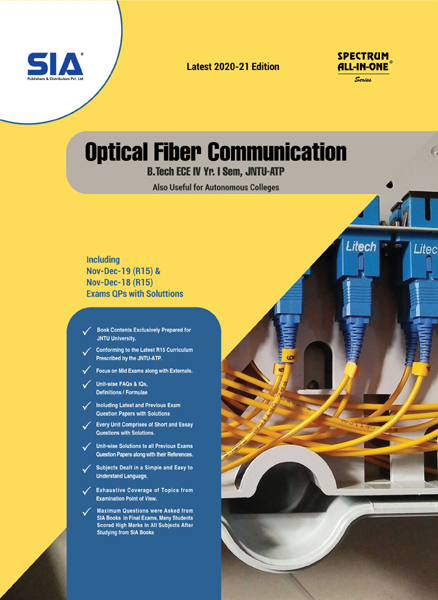

Note: Please check your Spam or Junk folder, in case you didn't receive the email with verification code.
SYLLABUS
UNIT-I
Introduction to Optical Fibers Evolution of fiber optic system – Element of an optical fiber transmission link – Ray optics – Optical fiber modes and configurations – Mode theory of circular wave guides – Overview of modes – Key modal concepts – Linearly polarized modes – Single Mode fibers-Graded Index fiber structure.
UNIT-II
Signal Degradation IN Optical fibers Attenuation – Absorption losses, Scattering losses, Bending losses, Core and cladding losses, Signal distortion in optical wave guides – Information capacity determination – Group delay – Material dispersion, Wave guide dispersion, Signal distortion in SM fibers – Polarization mode dispersion, Intermodal dispersion, Pulse broadening in GI fibers-Mode coupling – Design optimization of SM fibers-RI profile and cut-off wavelength.
UNIT-III
Fiber Optical Sources and Coupling Direct and indirect band gap materials – LED structures – Light source materials – Quantum efficiency and LED power, Modulation of a LED, Lasers diodes – Modes and threshold condition – Rate equations – External quantum efficiency – Resonant frequencies – Temperature effects, Introduction to quantum laser, Source-to-fiber power launching, Lensing schemes, Fiber-to-fiber joints, Fiber splicing.
UNIT-IV
Fiber Optical Receivers PIN and APD diodes – Photo detector noise, SNR, Detector response time, Avalanche multiplication Noise – Comparison of photo detectors – Fundamental receiver operation – Preamplifiers, Error sources – Receiver configuration – Probability of error – Quantum limit.
UNIT-V
System Design and Applications Design of Analog Systems: System specification, Power budget, Bandwidth budget Design of Digital Systems: System specification, Rise time budget, Power budget, Receiver sensitivity.
 No Preview is available for this book
No Preview is available for this book

 Get 100 instant uPoints on the purchase of Rs.100 or above for each order.
Get 100 instant uPoints on the purchase of Rs.100 or above for each order.
CategoriesEngineering

Format EPUB

TypeeBook